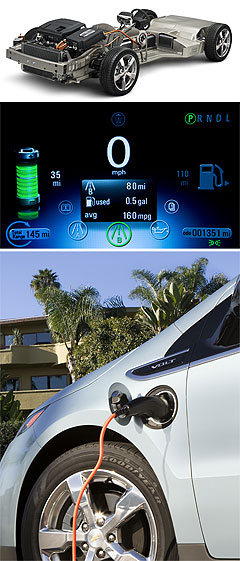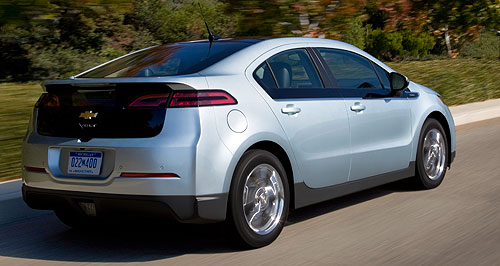Future models - Holden - VoltVolt batteries to retain their sparkExtender batteries: The Chevrolet Volt's battery pack will have a second life as power storage. GM says EV owners can sell spent lithium battery after the 10-year warranty expires7 Dec 2009 By BYRON MATHIOUDAKIS in LOS ANGELES GENERAL Motors says Volt’s batteries will have a ‘second life’ once they are spent. According to GM vice chairman Bob Lutz, the lithium ion batteries will still probably be worth around half their cost once their usefulness in the Volt electric range-extender vehicle ends after around a decade of use as the main motivator in the company’s range-extender electric vehicle. This is because the pack will be in high demand as a back-up power source at peoples’ homes or on properties in the event of a blackout emergency, as a secondary supply of electricity for industry that cannot afford to have a cut in electricity such as hospitals, or simply as an occasional-use source of voltage for camping trips and some such. GM has already announced that it will warranty the battery cells for a period of 10 years or 160,000 kilometres, but after that period there is still plenty of use (and money) left in the cells, and that an industry in used battery cells will spring up and thrive as a result. Furthermore, the cost of replacing a lithium ion battery will be around the same cost as having an engine overhaul on a used car, Mr Lutz believes. He revealed that GM had been purposefully conservative in its range estimates for the Volt’s battery pack, suggesting that the 60km pure electric range was based on the lithium ion cells packing about 70 per cent charge and still having around 20 per cent left. A full depletion would probably be about 140km.  “We are basically designing the battery for a 10-year or 100,000 mile (160,000km) life. At the end of that life … then the customer will have to bring (the Volt) into a dealer and get the battery replaced – which I estimate will probably cost as much as an engine overhaul on a traditional gasoline powered car. I don’t see why it should cost any more than that. “Plus, I think at some point, there is going to be a very large and stable, sustainable secondary market for spent automotive lithium ion batteries, because battery packs may no longer be willing to cycle as well on a daily basis, but they will still hold a 16 kilowatt per hour charge for emergency power systems at home or telecommunications centres or hospitals these batteries will still be there, they will still store all that energy, and since they are expected to be only drawn down occasionally when there is an emergency, they will still serve that purpose very, very well. “And I think in the secondary use market the lithium ion battery will still have a residual value of half of what it originally cost.” The second life situation with the battery pack, Mr Lutz said, should be applicable to the Holden-based Chevrolet Volt when it arrives in Australia from 2012, since the GM’s whole EV project has been designed as a global concern. “I would like to remind people that the Volt is an international car … and it has been designed from the outset to comply with all regulations in all major countries of the world, so it can be sold anywhere in the world without significant modification.” Meanwhile, Mr Lutz told the LA Show press day crowd that GM’s slow production start-up volume for Volt would virtually guarantee that it will be a sell-out. “We expect that demand will easily outstrip supply,” he said. “The plan right now is for around 8000 in the 2011 calendar year, and then ramping up to full capacity of around 50,000 to 60,000 per year.”  Read more7th of December 2009  GM doffs cap to TeslaWounded Goliath thanks David as inspiration for the Volt against Doubting Thomases23rd of November 2009  GM confirms Volt dateGM to commence production of US versions of its vital Volt in less than 12 months21st of August 2009  SA premier takes Holden hybrid case to DetroitRann urges GM CEO to build plug-in hybrid small car in Australia14th of August 2009  Holden expects 1.2L/100km city economy for VoltHolden’s plug-in hybrid to offer ultra-low city economy as GM proclaims 230mpg Volt11th of August 2009  Commodore hybrid out of the VoltHolden VE hybrid hopes alive after GM announces plug-in V6 for new Buick SUV |
Click to shareHolden modelsResearch Holden Motor industry news |
















Facebook Twitter Instagram